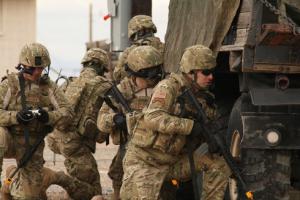Personal protection equipmentCotton candy machine inspires lighter bullet proof vests, and more
It is “boots on the ground” in this Harvard lab where the researchers are on a mission to protect U.S. troops on the battlefield. Researchersare developing next generation nanofibers at the Harvard Materials Research Science and Engineering Center (MRSEC). The researchers draw their inspiration from the cotton candy machine. They use their own version of that technology to spin a wide range of polymers, both natural and synthetic, into new fabrics and materials for military use.

Army evaluation combat team demonstration // Source: wikipedia.org
It is “boots on the ground” in this Harvard lab where the researchers are on a mission to protect U.S. troops on the battlefield.
Kit Parker is a lieutenant colonel in the Army Reserve and has served multiple tours of duty in Afghanistan. Even when he is not in uniform, this Harvard University bioengineer makes it his mission to protect the men and women of the U.S. armed forces — from improving wound dressings to designing lighter weight bullet proof vests.
The NSF says that Parker and his team are developing next generation nanofibers at the Harvard Materials Research Science and Engineering Center (MRSEC). The center is supported by the National Science Foundation (NSF). The overarching goal of the Harvard MRSEC is to perform transformative research that significantly advances the state of knowledge in several areas of soft matter science, and to educate the next generation of leaders in materials science and engineering.
The unlikely inspiration for Parker’s team is none other than the cotton candy machine. They use their own version of that technology to spin a wide range of polymers, both natural and synthetic, into new fabrics and materials for military use.
The NSF MRSECs provide sustained support of interdisciplinary materials research and education of the highest quality while addressing fundamental problems in science and engineering. The centers support materials research infrastructure in the United States, promote active collaboration between universities and other sectors, including industry and international institutions, and contribute to the development of a national network of university-based centers in materials research, education and facilities.
